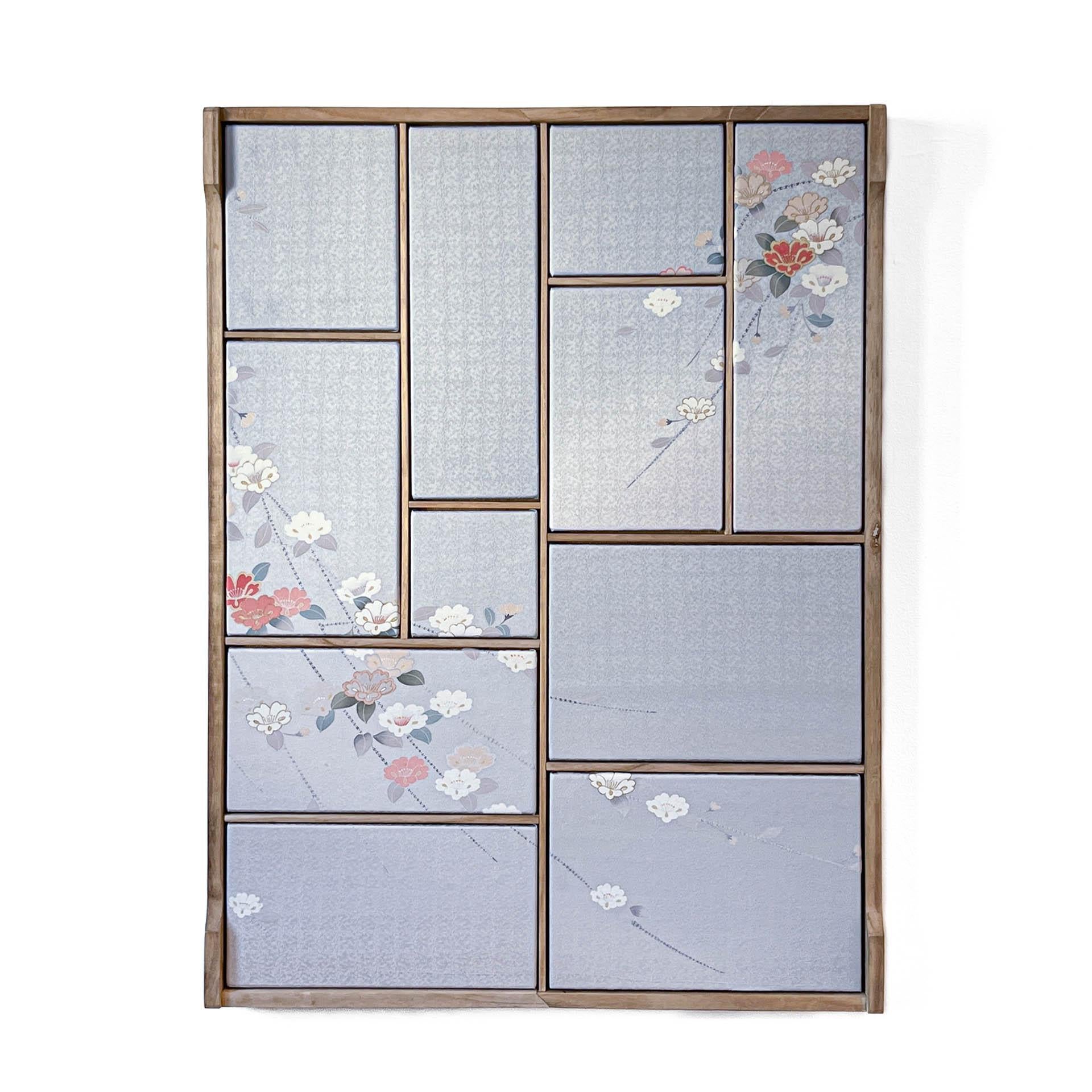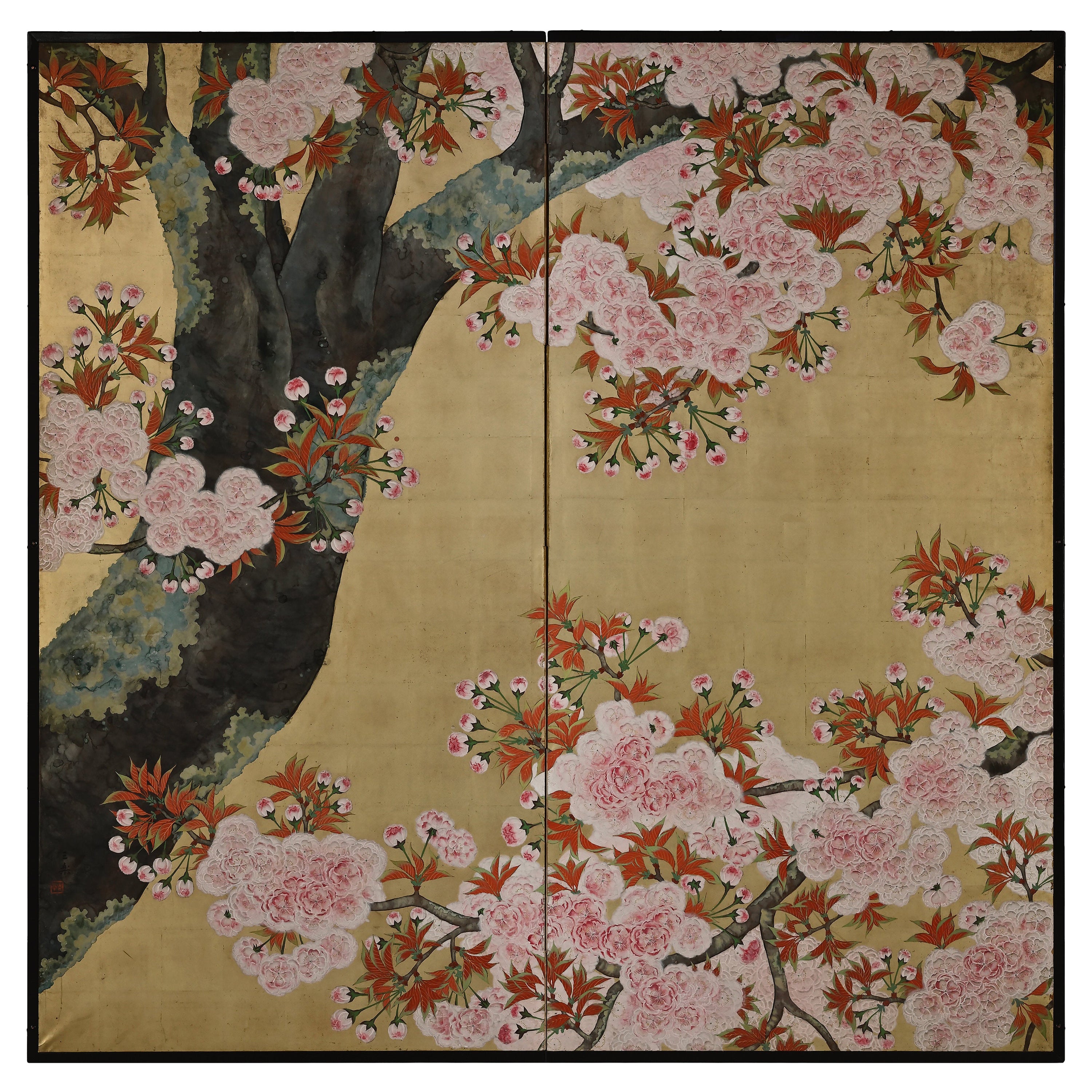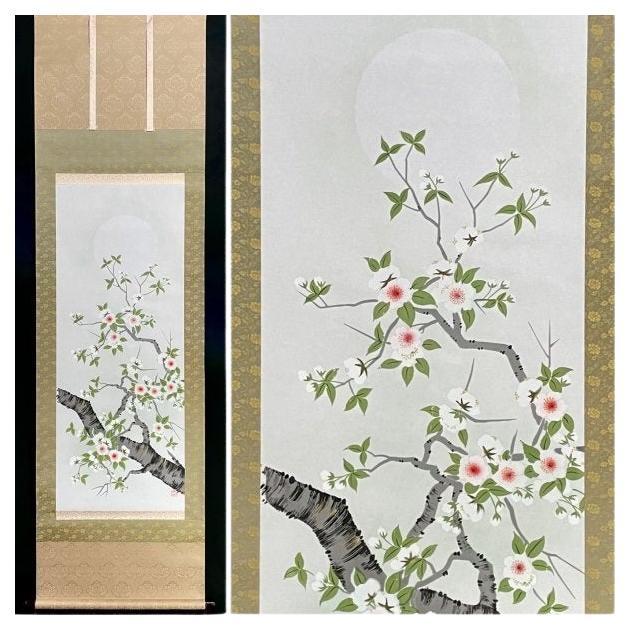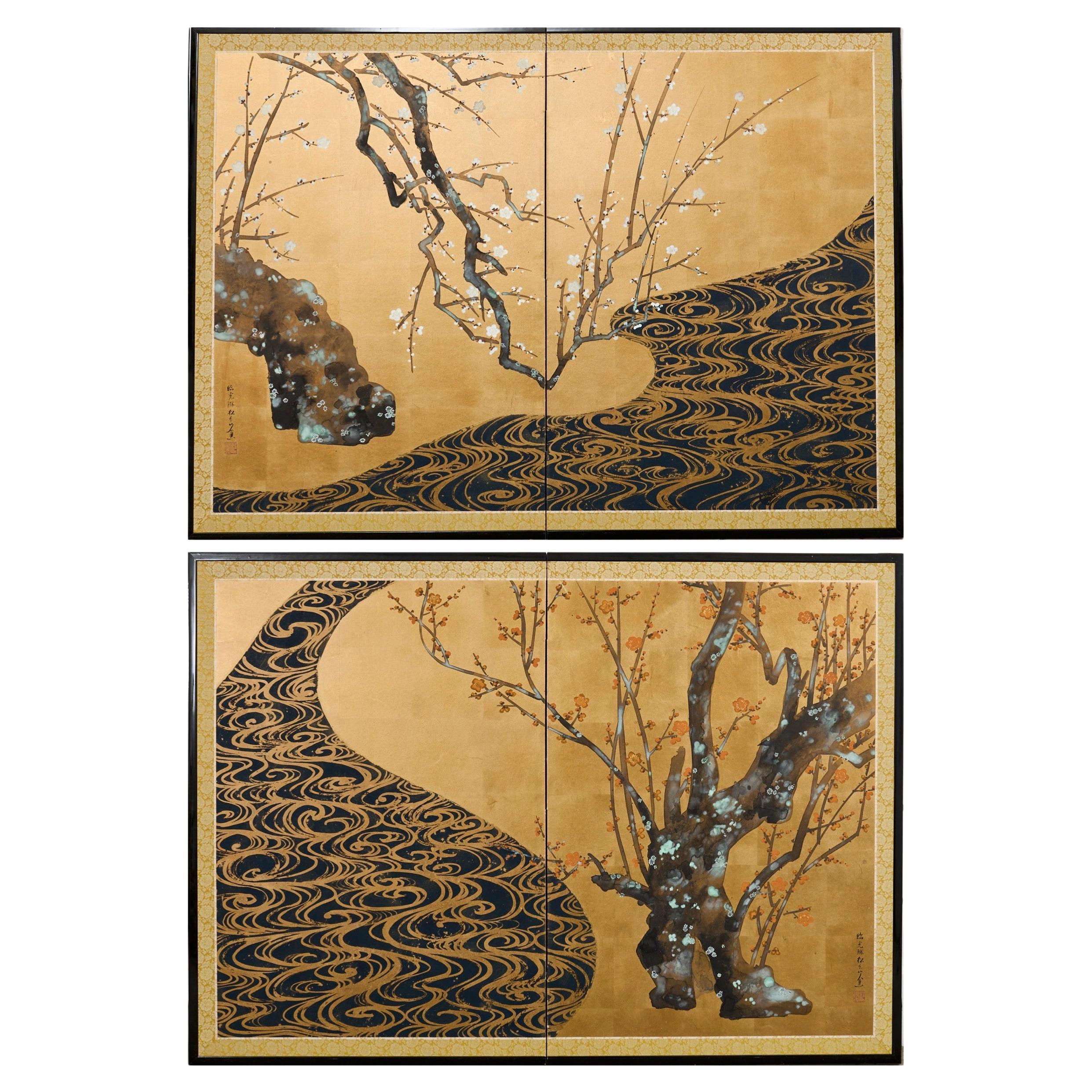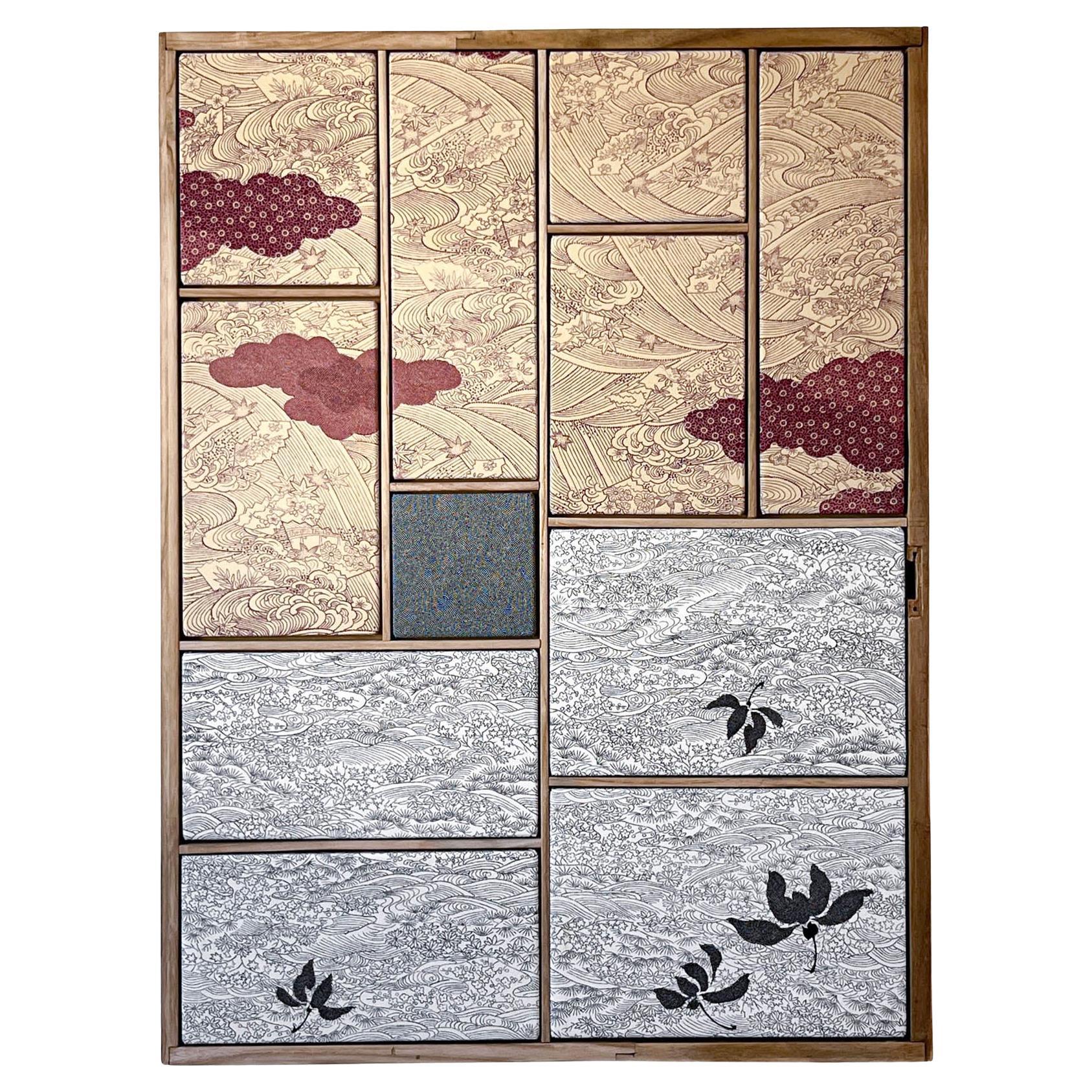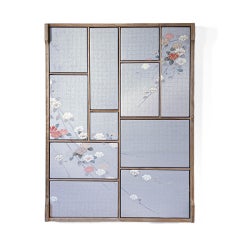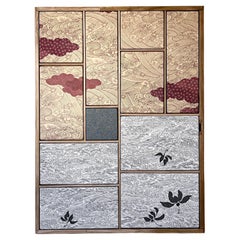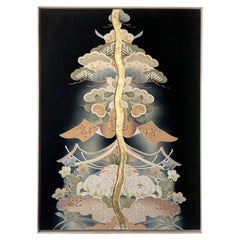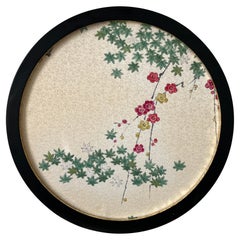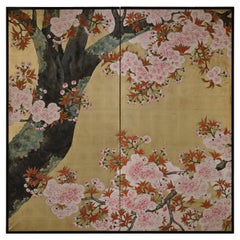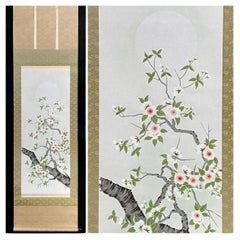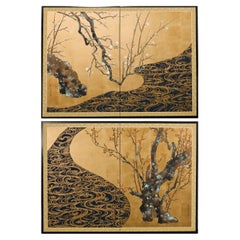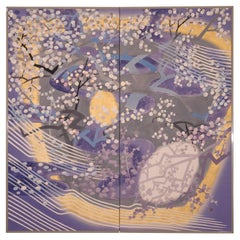Items Similar to Antique kimono textile art " Plum Blossom Night ~Resilience~ " by ikasu Japan
Video Loading
Want more images or videos?
Request additional images or videos from the seller
1 of 20
Antique kimono textile art " Plum Blossom Night ~Resilience~ " by ikasu Japan
$2,330
£1,781.41
€2,051.82
CA$3,265.04
A$3,645.12
CHF 1,909.99
MX$44,619.79
NOK 24,256.83
SEK 22,871.12
DKK 15,312.97
About the Item
This artwork uses antique fabric from Taisho era (early 1920ies) kimono and paulownia wood taken from antique kiritansu - chest-of-drawers used initially to keep kimonos.
It is elegantly framed with paulownia wood, a tree closely connected to kimono culture, and is filled with storytelling and sense of luxury.
I used two pieces of kimono that could no longer be used as clothing and silver leaf to create the ultimate upcycled piece.
The central line is inspired by traditional philisophy of kintsugi - appreciation of imperfection and antique.
<< Period / Story >>
The kimono used in this piece was originally crafted during Taisho period (1920ies).
<< Explanation and meaning of pattern and colors >>
In Japanese culture, the plum blossom, or ume (梅), holds significant symbolic value.
If we explore the idea of plum blossoms blooming at night, it might evoke a sense of quiet elegance and resilience. Nighttime blooming symbolizes beauty and grace emerging in challenging circumstances, as plum is one of the first flowers to bloom in severe winter. It might also suggest an appreciation for the subtle, understated beauty that isn’t always visible or recognized at first glance. This is also a metaphor for unused kimono - a material for this artwork, a beautiful piece that has been kept without using for a century till now when I gave it a second life as an artwork.
In this work, I empathized the “night” theme with ginpaku銀箔 - a traditional way of silver leafing originally used in pottery. Silver leaf is often used in traditional Japanese art and crafts, including painting, calligraphy, and the decoration of items like screens and ceramics, to add a luxurious and elegant touch. It is similar to gold leaf (kinpaku 金箔) but made from silver. I used ginpaku to depict stars in the sky, moonlight reflected in flowers center, and moonlight around (inside borders of the frame).
<< Characteristics of the fabric >>
The work uses antique materials and modern techniques and color combinations to create a valuable piece of history that fits perfectly in modern spaces.
<< About the frame >>
This artwork frame is crafted from paulownia wood, a uniquely Japanese material closely tied to the world of kimonos, and it serves to convey the refined beauty of Japanese nature.
Paulownia wood is known as the lightest wood in Japan, prased for its natural luster, resistance to moisture, and resilience against cracking. Since ancient times, it has been used in crafting furniture, chests, and musical instruments.
Paulownia wood is closely linked to kimono culture. During the Edo period, it became customary to store cherished kimonos in paulownia chests, which offered fire resistance and protection from moisture and insects.
Traditionally, when a daughter was born, a paulownia tree would be planted. Upon her marriage, the tree would be cut down, and the wood would be used to craft a chest for her as a wedding gift.
Following the Ansei Earthquake during the late Edo period in 1855, paulownia chests gained popularity due to their ability to withstand fires and even float in water, thereby safeguarding their contents during floods.
- Creator:Kimono ikasu (Artist)
- Dimensions:Height: 28.75 in (73 cm)Width: 20.87 in (53 cm)Depth: 1.97 in (5 cm)
- Style:Japonisme (In the Style Of)
- Materials and Techniques:
- Place of Origin:
- Period:
- Date of Manufacture:around 1920ies
- Condition:
- Seller Location:Setagaya City, JP
- Reference Number:1stDibs: LU10079243793442
About the Seller
No Reviews Yet
Vetted Professional Seller
Every seller passes strict standards for authenticity and reliability
1stDibs seller since 2024
- ShippingRetrieving quote...Shipping from: Setagaya City, Japan
- Return Policy
Authenticity Guarantee
In the unlikely event there’s an issue with an item’s authenticity, contact us within 1 year for a full refund. DetailsMoney-Back Guarantee
If your item is not as described, is damaged in transit, or does not arrive, contact us within 7 days for a full refund. Details24-Hour Cancellation
You have a 24-hour grace period in which to reconsider your purchase, with no questions asked.Vetted Professional Sellers
Our world-class sellers must adhere to strict standards for service and quality, maintaining the integrity of our listings.Price-Match Guarantee
If you find that a seller listed the same item for a lower price elsewhere, we’ll match it.Trusted Global Delivery
Our best-in-class carrier network provides specialized shipping options worldwide, including custom delivery.More From This Seller
View AllVintage obi textile art " Camellia ~ Serendipity ~ " by ikasu Blue, Japan
By Kimono ikasu
Located in Setagaya City, JP
This work is inspired by traditional Japanese nature motifs symbolism, and is framed in paulownia wood originally used for a kimono chest-of-drawers.
In this artwork, the aim was to capture the the auspicious symbol of camellia used in antique kimono. Traditional Japanese culture, represented by the kimono, and wood, an integral element of Japanese craftsmanship, were used to bring this vision to life.
I used pieces of kimono that could no longer be used as clothing and kiritansu chest-of-drawers that would normally be discarded to create the ultimate upcycled piece.
<< Explanation and meaning of pattern and colors >>
This delicate piece features hand-drawn camellia motifs flowing gracefully on a softly brightened grayish background.
Camellias, native to Japan, bloom from winter to early spring. As an evergreen tree with green leaves throughout the year, it symbolizes the anticipation of spring and is considered an auspicious plant. Due to its seasonal significance and auspicious meanings, camellias have been used as motifs symbolizing good fortune. Additionally, they were highly valued for their use in oil, cosmetics, and medicine, representing nobility. Believed to possess the power to ward off misfortune, camellias also carry the meaning of "protection from calamity" and have strong ties to traditional ceremonies. In this artwork, camellias are delicately depicted alongside flowing branches, subtly representing good fortune with their pale pink and white hues.
"Sora-iro nezumi 空色鼠" refers to a light grayish color with a hint of blue, reminiscent of the slightly brightened sky on a lightly cloudy day. Popular during the late Edo period (19th cent.), it elegantly captures the slightly brighter sky pattern seen on lightly overcast days. Notably, the term "nezumi-iro" (mouse gray), popular during the late Edo period, was paired with brown tones, collectively known as "Forty-eight Teas and a Hundred Mice 四十八茶百鼠." Colors within the "nezumi" (gray) spectrum, particularly "sora-iro nezumi," were favored by young people for their cool and sophisticated appeal.
<< Characteristics of the fabric >>
The fabric features intricately woven patterns that reveal subtle gradations through dyeing, creating a grid pattern that transforms depending on the light conditions.
Originally, this fabric was part of a formal kimono known as a "hōmongi 訪問着," featuring motifs along the hem, shoulders, and sleeves. These motifs have been carefully selected and combined to create a unified piece of artwork.
<< About the frame >>
Kiritansu - chest-of-drawers for kimono, is traditionally made from paulownia wood, a uniquely Japanese material closely tied to the world of kimonos.
Paulownia wood is known as the lightest wood in Japan, prased for its natural luster, resistance to moisture, and resilience against cracking. Since ancient times, it has been used in crafting furniture, chests, and musical instruments.
During the Edo period, it became customary to store cherished kimonos in paulownia chests...
Category
Vintage 1960s Japanese Japonisme Paintings and Screens
Materials
Silk, Wood
Antique kimono textile art " Waves and clouds ~Eternity~ " by ikasu Beige, Japan
By Kimono ikasu
Located in Setagaya City, JP
This work is inspired by traditional hand-dying technique edo-komon, and is framed in paulownia wood originally used for a kimono chest-of-drawers.
It is elegantly framed with paulo...
Category
Vintage 1920s Japanese Japonisme Paintings and Screens
Materials
Silk, Wood
Antique kimono textile art "Prosperity Tree" by ikasu Black, Japan
By Kimono ikasu
Located in Setagaya City, JP
This work uses an antique kimono fabric dated Taisho era (early 1910th), with a pine tree motif, and arranges it so that it looks like a tree decorated with various auspicious symbols - persimmons, pines, peonies, etc.
The line in the middle symbolizes “kintsugi” - concept of wabi-sabi, which values imperfection, impermanence, and the beauty of aging.
It is elegantly framed with paulownia wood originally used for kimono chest-of-drawers, and is filled with storytelling and sense of luxury.
I used pieces of kimono that could no longer be used as clothing and kiritansu chest-of-drawers that would normally be discarded to create the ultimate upcycled piece.
<< Explanation and meaning of pattern and colors >>
The art work features the matsu - pine pattern, which depicts the Japanese pine tree spreading over deep black fabric. It appears as if the pine dranches are decorated with various auspicious symbols - persimmons, pines, peonies, etc.
In East Asia, the pine tree is revered as a symbol of longevity due to its vibrant green leaves, even during the winter season.
In Japan, it's often referred to as the "evergreen tree" because its leaves remain green throughout the year, making it a symbol of good fortune that has been cherished for a long time.
<< Characteristics of the fabric >>
The fabric is hand-painted in traditional Japanese technique "yuzen".
<< About the frame >>
Kiritansu - chest-of-drawers for kimono, is traditionally made from paulownia wood, a uniquely Japanese material closely tied to the world of kimonos.
Paulownia wood is known as the lightest wood in Japan, prased for its natural luster, resistance to moisture, and resilience against cracking. Since ancient times, it has been used in crafting furniture, chests, and musical instruments.
During the Edo period, it became customary to store cherished kimonos in paulownia chests...
Category
Early 20th Century Japanese Japonisme Paintings and Screens
Materials
Gold Leaf
Vintage kimono textile art "View from the Window ~Maple&Plum~" by ikasu, Japan
By Kimono ikasu
Located in Setagaya City, JP
This work is a glorious nod to buddhist temples circle windows, with beautiful Japanese garden scape seen outside. Golden leaf on the border of a frame is an expression of light goin...
Category
Vintage 1930s Japanese Japonisme Paintings and Screens
Materials
Gold Leaf
Antique obi textile art " Pine forest ~ Longivety ~ " by ikasu Green , Japan
By Kimono ikasu
Located in Setagaya City, JP
<< Story behind the work >>
Obi fabric I used for this artwork is taken from three different over 100-years-old antique sashes, and is framed in wood taken from antique chest-of-dra...
Category
Early 20th Century Japanese Japonisme Paintings and Screens
Materials
Gold Leaf
Vintage kimono textile art "Fern ~Connection to Nature~" by ikasu Black , Japan
By Kimono ikasu
Located in Setagaya City, JP
This work uses an antique tomesode (festive kind of kimono) with fern design to evoke feelings of tranquility, harmony, and appreciation for the beauty of the environment. Can be used both vertically and horizontally.
It is elegantly framed with paulownia wood originally used for kimono chest-of-drawers, and is filled with storytelling and sense of luxury.
I used pieces of kimono that could no longer be used as clothing and kiritansu chest-of-drawers that would normally be discarded to create the ultimate upcycled piece.
<< Explanation of colors and patterns >>
In Japanese traditional culture, ferns, particularly the Japanese painted fern (Athyrium niponicum), hold several meanings and symbolisms:
・Elegance and Beauty: Ferns are admired for their graceful, delicate appearance and intricate leaf patterns. In Japanese aesthetics, they are appreciated for their natural beauty and are often used in gardens, landscapes, and floral arrangements to add a sense of refinement and elegance.
・Resilience and Perseverance: Ferns are known for their ability to thrive in diverse environments, including shady forests, rocky cliffs, and damp soil. Their resilience in the face of challenging conditions is seen as a symbol of endurance and perseverance. In Japanese culture, ferns may represent the ability to overcome adversity and flourish despite obstacles.
・Connection to Nature and Tranquility: Ferns are native to forested areas and are often associated with the natural world. In Japanese traditional culture, they symbolize a deep connection to nature and the importance of maintaining harmony with the environment. The lush green foliage of ferns evokes feelings of tranquility and peacefulness, making them popular motifs in Zen gardens and traditional landscape paintings.
・Purity and Simplicity: Ferns are emblematic of simplicity and purity in Japanese aesthetics. Their unassuming beauty and understated elegance reflect the principles of wabi-sabi, an aesthetic worldview that values imperfection, impermanence, and simplicity. Ferns may be used in tea ceremonies, Ikebana (flower arranging), and other traditional arts to evoke a sense of tranquility and appreciation for life's fleeting moments.
Overall, ferns in Japanese traditional culture symbolize elegance, resilience, connection to nature, purity, and simplicity. Their presence in art, literature, and landscape design underscores their enduring significance as symbols of natural beauty and spiritual resonance.
<< Characteristics of the fabric >>
This vintage textile is hand-painted with a traditional Japanese technique called "yuzen".
<< About the frame >>
Kiritansu - chest-of-drawers for kimono, is traditionally made from paulownia wood, a uniquely Japanese material closely tied to the world of kimonos.
Paulownia wood is known as the lightest wood in Japan, prased for its natural luster, resistance to moisture, and resilience against cracking. Since ancient times, it has been used in crafting furniture, chests, and musical instruments.
During the Edo period, it became customary to store cherished kimonos in paulownia chests...
Category
Vintage 1960s Japanese Japonisme Paintings and Screens
Materials
Silk, Wood
You May Also Like
Early 20th Century Japanese Cherry Blossom Screen by Kano Sanrakuki
Located in Kyoto, JP
Cherry Blossoms
Kano Sanrakuki (1898-1981)
Showa period, circa 1930
2-panel Japanese Screen
Color, gofun and gold leaf on paper
Against a backdrop of gold-leafed ground, the lichen covered trunk and branches of the life-sized cherry blossom tree reach out and beyond the confines of the pictorial surface. The overall composition has a feeling of flatness which draws emphasis to the surface and the three-dimensionality of the cherry blossoms. Painstakingly built-up layers of thickly applied shell-white gofun detail the voluminous blossoms and cover large areas of this tour-de-force of Japanese Nihonga painting. By simplifying the background, minimizing the number of colors and depicting the blossoms with such heavy relief, the artist has emphasized the stunning presence of the cherry tree. The type of tree depicted is the Yae-Zakura; a double-layered type of cherry blossom famed for its beauty and strength. When we think of Japanese cherry blossoms, the first thing that comes to mind is Somei Yoshino variety, which has a single flower with five almost white petals. This type is fragile and easily blown away by strong wind or rain. Most of the double-flowered cherry blossoms begin to bloom when the Somei-Yoshino falls, and the flowering period lasts longer than that of the Somei-Yoshino.
Kano Sanrakuki originally studied painting at the Kyoto City Arts and Crafts School under the tutelage of Yamamoto Shunkyo...
Category
Early 20th Century Japanese Showa Paintings and Screens
Materials
Gold Leaf
Lovely Japanese 20th c Scroll Cherry Blossoms in the Moon
Located in Amsterdam, Noord Holland
This work carefully and delicately depicts a river landscape
■Silk book, handwritten
■Condition
Lovely Condition
■Dimensions
Axis size: 1845mm (height) x 530mm (width)
Paper size...
Category
20th Century Paintings
Materials
Silk
$461 Sale Price
20% Off
Pair of Red and White Plum Blossom Screens After Ogata Korin
Located in Rio Vista, CA
Amazing pair of 18th century Edo period style paintings of red and white plum blossoms after Ogata Korin (Japanese 1658-1716). One of the most famous paintings in Japan where it is r...
Category
20th Century Japanese Edo Paintings and Screens
Materials
Brass, Gold Leaf
Japanese Two Panel Screen: Yozakura (Cherry Blossom Viewing at Night)
Located in Hudson, NY
Unusual subject matter of cherry blossoms in the moonlight on dyed silk and applied gold in a grey lacquer trim. Signature and seal read: Adachi Masakazu. ...
Category
20th Century Japanese Paintings and Screens
Materials
Gold
Framed Japanese Festival Kimono with Tsutshugaki Dye
Located in Atlanta, GA
A Japanese festival kimono expertly mounted and displayed in a large acrylic shadow box. This impressive ceremonial garment circa late 19th-early 20th century was made from a thick l...
Category
Early 20th Century Japanese Japonisme Textiles
Materials
Textile, Acrylic
Japanese Two Panel Screen: Floral Tarashikomi
Located in Hudson, NY
An unusual floral screen covered entirely in the tarashikomi technique of the famed Rimpa School creating an archaic feel. Mineral pigments and ink on silver with a silk brocade bord...
Category
Antique Late 19th Century Japanese Paintings and Screens
Materials
Silver
More Ways To Browse
Japanese Fabric Art
Japanese Kimono
Japanese Used Kimono
Upcycle Art
Plum Wood
Framed Japanese Textiles
Antique Tills
Gold Kimono
Antique Gold Silk Fabric
Tree Of Life Fabric
Asian Painted Drawers
Framed Insects
Antique Chest With Paintings
Hand Painted Kimono
Marriage Chest
Japanese Kimono Fabric
Japanese Silk Screen Flowers
Antique Japanese Calligraphy
